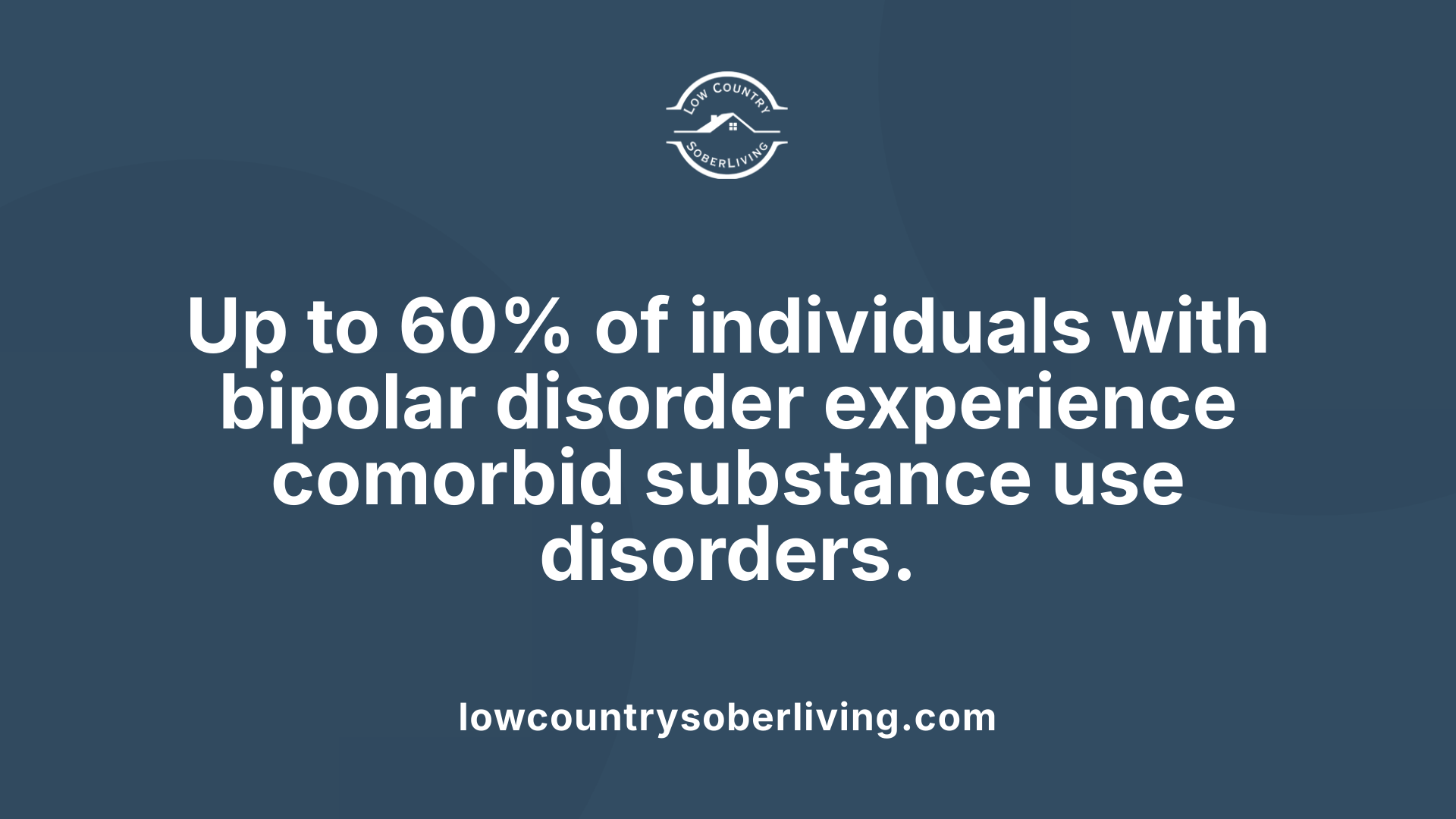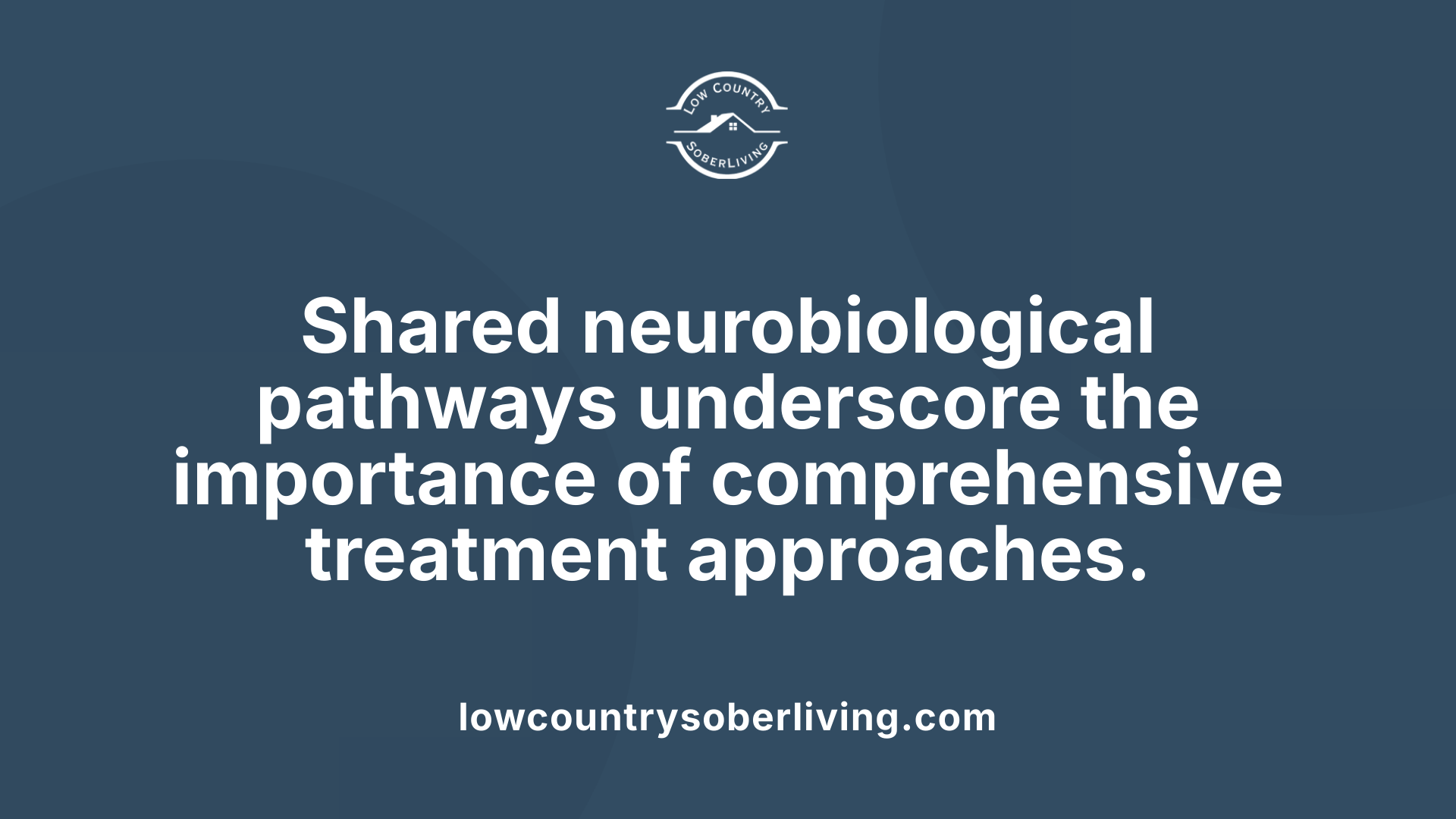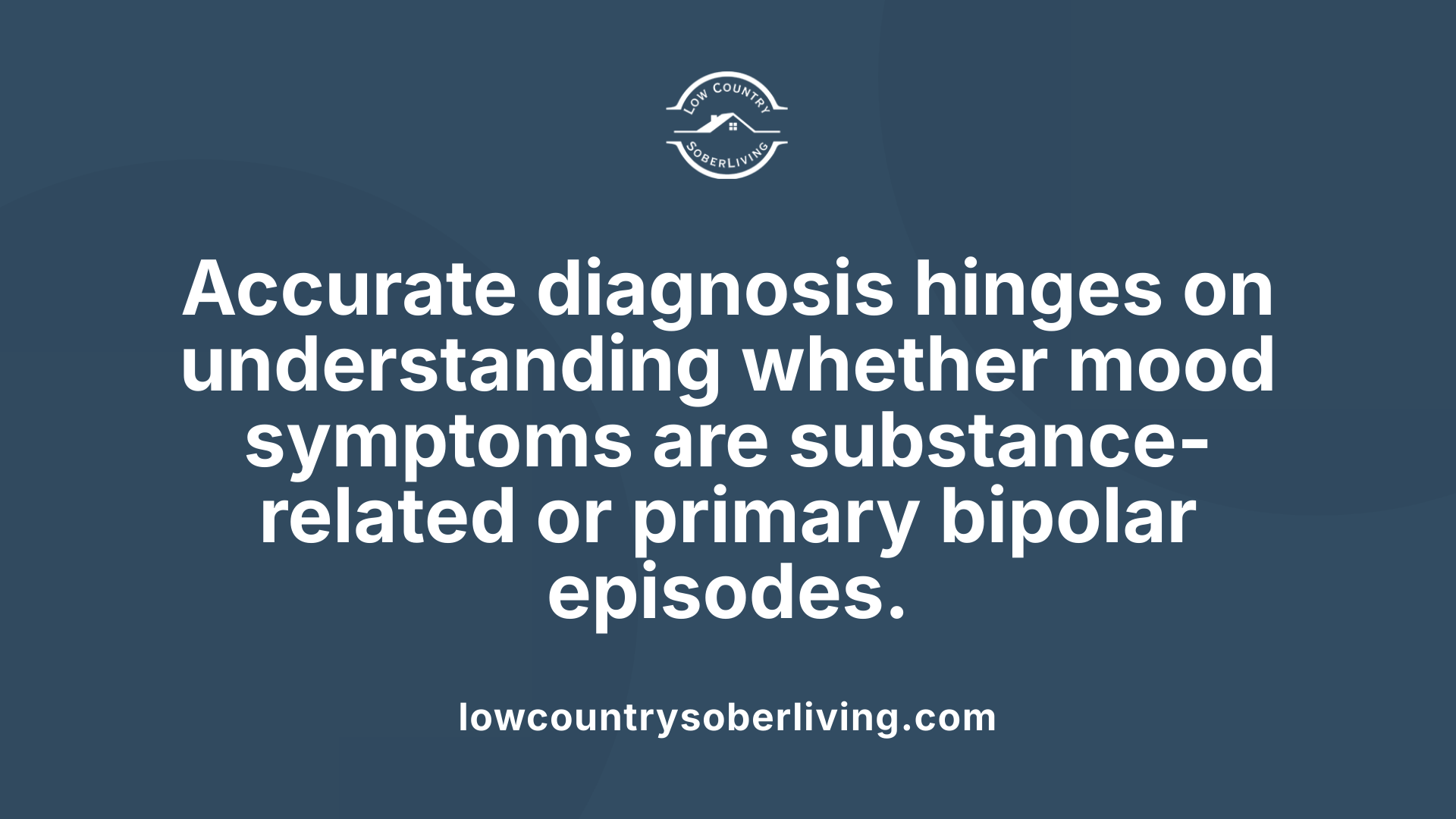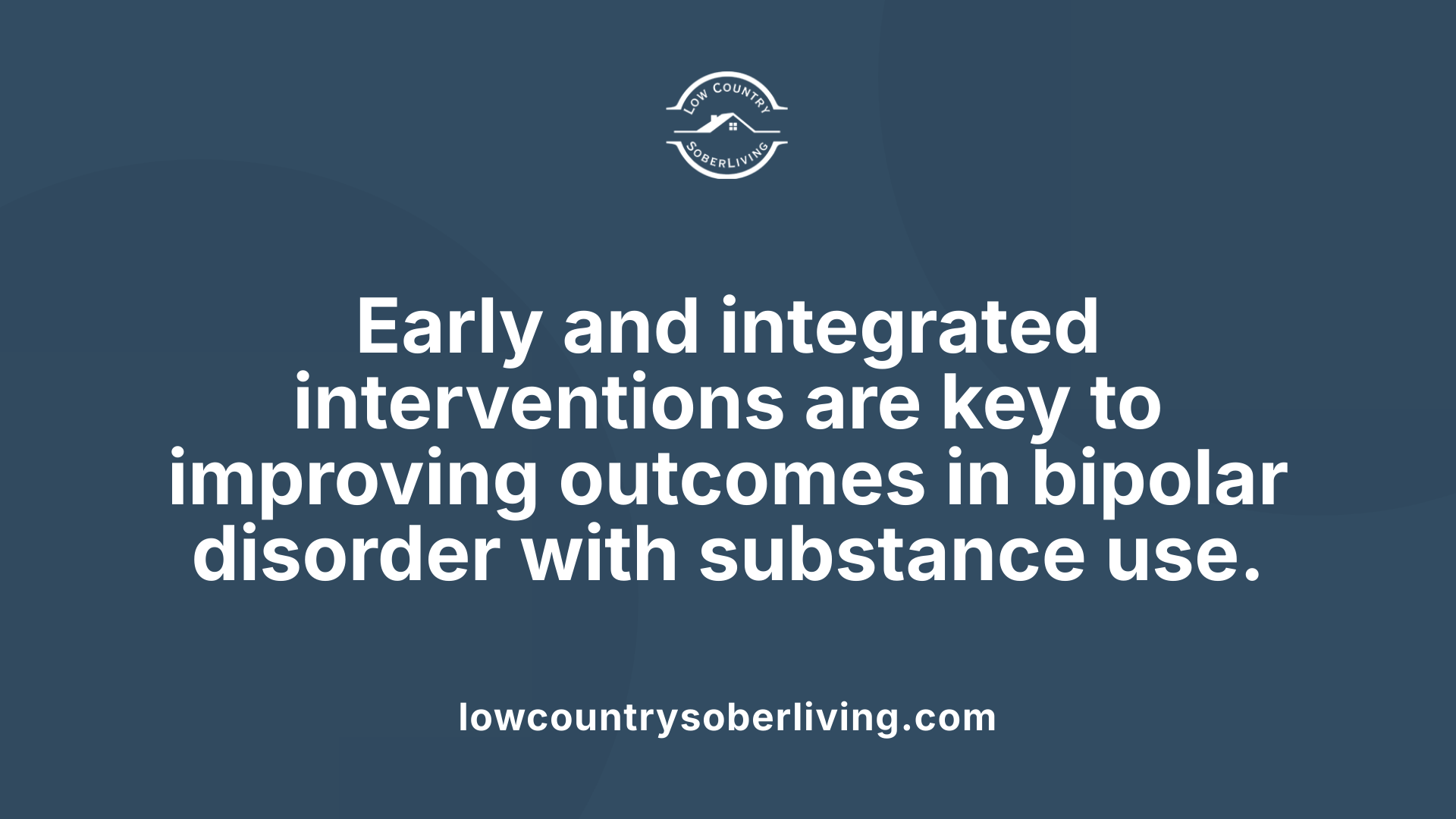Understanding the Relationship Between Drug Abuse and Bipolar Disorder
The connection between drug abuse and bipolar disorder is a multifaceted issue, involving complex interactions of neurobiological, genetic, and environmental factors. While current evidence suggests that substance misuse does not directly cause bipolar disorder, it significantly influences its onset, progression, and management. This article explores whether drug abuse can lead to the development of bipolar disorder, examines the mechanisms involved, and discusses implications for diagnosis and treatment.
The Prevalence of Substance Use in Bipolar Disorder

What is the relationship between substance abuse and bipolar disorder?
Substance abuse and bipolar disorder are closely connected, with studies showing that as many as 60% of people with bipolar disorder have experienced some form of substance use disorder at some point in their lives. This high prevalence suggests a significant overlap between the two conditions.
Many individuals with bipolar disorder turn to alcohol or drugs as a way to manage or self-medicate their symptoms. For example, during depressive phases, some may use alcohol or sedatives to soothe their mood, while during manic episodes, stimulants might be used to boost energy. However, this self-medication often worsens the overall course of the disorder.
Research indicates that substance abuse not only complicates diagnosis but also influences the severity and progression of bipolar disorder. Those with co-occurring substance use tend to experience earlier onset of symptoms, more irritable and dysphoric moods, and increased resistance to treatment.
Neurobiological studies highlight that both conditions impact neurotransmitter systems in the brain, particularly those governing reward and motivation. There's also evidence for shared genetic factors, meaning some individuals are predisposed to both bipolar disorder and addiction. This interconnectedness underscores the importance of addressing both issues in treatment.
Effective management involves integrated approaches, combining medication, psychotherapy, and support systems aimed at both stabilizing mood and reducing substance use. Treatment success is often linked to early intervention and comprehensive care plans that consider the complex relationship between these disorders.
Can drug and alcohol abuse cause bipolar disorder?
Current findings suggest that substance abuse does not directly cause bipolar disorder. Instead, the relationship is more nuanced.
While drugs and alcohol do not create bipolar disorder from scratch, they can significantly influence its development and course. Substance use can trigger mood episodes or make existing symptoms worse, particularly in individuals who are genetically or otherwise predisposed.
Certain recreational drugs and medications can induce mood symptoms resembling bipolar episodes; these are known as substance-induced mood disorders. For instance, stimulants like cocaine may induce manic-like behaviors, while depressants like alcohol can mimic depressive symptoms.
Moreover, substance dependency often complicates the clinical picture, making diagnosis and treatment more challenging. It also increases the risk of rapid mood swings, higher rates of hospitalization, and a more severe disease trajectory.
Overall, while substance use impacts the management and progression of bipolar disorder, it is not considered a primary cause. The intricate relationship highlights the importance of addressing substance use in individuals diagnosed with bipolar disorder to improve outcomes.
Neurobiological and Genetic Influences

How does drug abuse impact the development or progression of bipolar disorder?
Substance abuse has a significant role in influencing the onset and course of bipolar disorder. It often acts as a trigger for mood episodes, worsening existing symptoms or prompting new mood fluctuations. Studies estimate that as many as 60% of individuals with bipolar disorder also experience substance use disorders, which tend to lead to an earlier onset of bipolar symptoms.
Using drugs or alcohol can interfere with brain chemistry, especially neurotransmitter systems responsible for mood regulation. This disruption can make bipolar symptoms more severe, with increased mood instability, irritability, and dysphoric states. Moreover, substance abuse complicates treatment, often reducing the effectiveness of medications like lithium and increasing the need for hospitalizations.
Many individuals turn to substances to self-medicate during depressive or manic episodes. While this might temporarily soothe distress, it ultimately worsens the disorder's progression, raising the likelihood of relapse, treatment resistance, and adverse outcomes such as increased risk for psychosis, suicide, and risky behaviors. Therefore, addressing substance use is critical in managing bipolar disorder effectively.
What are the shared neurobiological mechanisms in bipolar disorder and substance addiction?
Both conditions involve profound dysregulation of brain neurotransmitter systems, particularly within neural circuits governing reward, motivation, and mood regulation. Chronic substance use causes physical alterations in these pathways, especially in areas like the mesolimbic tract and Papez circuit. These neurobiological changes can lead to psychological instability, making mood swings more intense and frequent.
Research indicates that the brain's reward system, which relies heavily on neurotransmitters such as dopamine, serotonin, and norepinephrine, is affected in both bipolar disorder and substance addiction. In bipolar disorder, chemical imbalances contribute to mood episodes, while in addiction, these imbalances reinforce drug-seeking behavior.
Genetic predispositions further intertwine these conditions. There is evidence of shared genetic factors that increase susceptibility to both bipolar disorder and addiction. For example, certain gene variants influence neurotransmitter functioning, making some individuals more vulnerable to developing either or both disorders.
This overlap in neurobiological mechanisms explains why comorbid bipolar disorder and substance use disorder are so common. It also highlights the importance of treatments that address these shared pathways to improve patient outcomes and reduce relapse risk.
| Aspect | Details | Additional Insights |
|---|---|---|
| Brain Circuits Involved | Mesolimbic tract, Papez circuit | Crucial for reward, motivation, and mood regulation |
| Neurotransmitter Systems | Dopamine, serotonin, norepinephrine | Dysregulation affects mood stability and addiction tendencies |
| Genetic Factors | Shared genetic variants | Increase vulnerability to both disorders |
| Neurobiological Changes | Structural and functional alterations | Caused by chronic substance use, impacting mood regulation |
| Impact on Treatment | Increased treatment resistance | Due to neurochemical imbalances and brain adaptations |
More about the neurobiology of substance use and bipolar disorder
For a deeper understanding, further reading on the neurobiological links between substance use and bipolar disorder can be explored using search terms like "Neurobiology of substance use and bipolar disorder." Recognizing these shared pathways underscores the necessity of integrated treatment approaches targeting both neurochemical and behavioral aspects to improve prognosis and quality of life for affected individuals.
Substance-Induced Mood Disorders and Diagnostic Challenges

How substances can mimic or trigger bipolar symptoms
Many substances, including recreational drugs and certain medications, can produce mood symptoms similar to those seen in bipolar disorder. During intoxication or withdrawal, these substances may cause mood swings, irritability, or depressive states. For example, stimulants like cocaine and methamphetamines can lead to euphoria, increased energy, and paranoia—features that mirror manic episodes. Conversely, depressants such as alcohol and opioids often result in lowered mood and fatigue, resembling depressive phases.
Substances like hallucinogens (LSD, mushrooms, PCP), corticosteroids, and even some blood pressure medications can influence brain chemistry, triggering mood episodes. Heavy metals and chemicals in paints, solvents, or gasoline may also cause mood disturbances when exposure occurs. These drug- or toxin-related effects can complicate diagnosis because symptoms may appear identical to primary bipolar episodes.
Importantly, these substance-induced symptoms are typically transient, often resolving within about a month after stopping the substance. Recognizing whether mood changes stem from substances or an underlying bipolar disorder requires careful assessment of the timing and context of symptoms.
DSM-5 criteria for substance-induced bipolar disorder
The DSM-5-TR specifies that substance-induced bipolar disorder involves a mood disturbance—such as a manic or hypomanic episode—directly caused by the physiological effects of a substance. To meet this diagnosis, certain criteria must be satisfied:
- Symptoms must occur during intoxication, withdrawal, or shortly after medication exposure.
- The mood disturbance is not better explained by a primary mood disorder.
- The episode’s severity results in significant distress or impairment, possibly requiring hospitalization.
- Evidence exists that symptoms began or worsened with substance use.
During assessment, clinicians look for the temporal relationship between substance intake and mood symptoms. They also evaluate whether symptoms persist after substance effects subside, which can suggest a primary mood disorder rather than a substance-induced one.
Differentiating between primary bipolar disorder and substance-induced mood episodes
Distinguishing primary bipolar disorder from substance-induced episodes can be challenging. Key factors include:
| Aspect | Primary Bipolar Disorder | Substance-Induced Mood Disorder | Explanation |
|---|---|---|---|
| Onset | Usually episodic, often in early adulthood | Often temporally related to substance use or withdrawal | Timeline helps differentiate, with substance episodes tightly linked to drug exposure |
| Duration | Mood episodes persist beyond substance effects | Mood symptoms resolve within a month post-cessation | Persistence indicates a primary mood disorder |
| Pattern | Recurrent episodes with inter-episode recovery | Symptoms emerge during or soon after substance use | Consistent episodes point toward bipolar disorder |
| Family history | Often present | Usually absent or less evident | Genetic predisposition suggests primary bipolar diagnosis |
Clinicians must carefully evaluate history, substance use patterns, and symptom persistence to ensure accurate diagnosis. Misdiagnosis can lead to ineffective treatments, so understanding the context of mood episodes is crucial for proper management.
Treatment, Outcomes, and Prognosis
Does drug-induced bipolar disorder go away?
Drug-induced bipolar disorder typically diminishes after stopping the offending substance. Symptoms such as mania or depression linked to drug use often improve within about one month following cessation. Accurate diagnosis hinges on understanding when symptoms appeared relative to substance use, helping distinguish between primary bipolar disorder and substance-induced mood episodes.
Effective treatment supports abstinence from alcohol, stimulants, and other drugs, and may involve medications and psychotherapy to manage residual mood symptoms. Long-term, the prognosis for drug-induced bipolar disorder is generally favorable if the individual maintains sobriety. Preventing relapse and supporting ongoing recovery are crucial for lasting mood stability.
How does drug abuse impact the development or progression of bipolar disorder?
Substance abuse plays a substantial role in both the onset and worsening of bipolar disorder. It can act as a trigger for mood episodes and intensify existing symptoms. Studies indicate that more than half of individuals with bipolar disorder have a history of substance use disorder, which correlates with an earlier disease onset, more severe illness, and frequent relapses.
Drugs, especially alcohol and stimulants, disrupt neurotransmitter systems involved in mood regulation, like dopamine and serotonin. This neurochemical chaos can lead to neurobiological changes that heighten emotional volatility and impair treatment responsiveness. Many patients turn to substances as self-medication during depressive or manic episodes, which can further muddle diagnosis and complicate management.
Consequently, addressing both conditions simultaneously is essential. Integrated care—combining medication, psychotherapy, and support services—aims to stabilize mood, reduce substance cravings, and improve overall outcomes. These strategies help prevent progressive deterioration and support sustained recovery.
| Aspect | Impact | Additional Details | | Inception of disorder | Substance use can trigger bipolar episodes | Especially when use begins during adolescence or young adulthood | | Disease progression | Worsening symptoms and relapse | Increased hospitalizations, mood instability | | Treatment response | Reduced effectiveness of medication | Due to neurochemical alterations caused by substances | | Long-term outlook | Improved with integrated treatment | Ongoing abstinence and comprehensive therapy are crucial |
Understanding how substance abuse influences bipolar disorder underscores the importance of early intervention, integrated treatment, and continuous support to enhance prognoses and improve quality of life.
Implications for Treatment and Management

Why is early intervention important?
Early intervention plays a vital role in managing bipolar disorder, especially when substance use is also involved. Addressing symptoms promptly can prevent worsening of the disorder and reduce the risk of long-term complications. Younger individuals, particularly adolescents, are more vulnerable to the intertwined impact of bipolar symptoms and substance abuse, which can escalate quickly without treatment.
Prompt treatment helps in stabilizing mood episodes, reducing the frequency and severity of manic or depressive states. It also minimizes the chances of developing additional disorders like substance dependence, which can complicate the course of bipolar illness.
Effective early management involves comprehensive assessment and swift initiation of tailored therapies. This approach not only improves immediate outcomes but also enhances the overall prognosis, supporting better social, educational, and occupational functioning in the long term.
Integrated therapy approaches for co-occurring disorders
Treating bipolar disorder alongside substance use disorder requires coordinated, multidimensional strategies. Integrated therapy models combine approaches aimed at both conditions simultaneously. These include cognitive-behavioral therapy (CBT), dialectical behavior therapy (DBT), group therapy, and supportive counseling.
CBT helps individuals recognize and modify thoughts and behaviors associated with substance use and mood swings. DBT, with its focus on emotional regulation and distress tolerance, is particularly effective for mood stabilization and reducing impulsivity.
Group therapy provides peer support and shared understanding, aiding recovery and reinforcing coping skills. Supportive services such as social skills training, vocational rehabilitation, and family therapy also play critical roles.
Nutrition, lifestyle counseling, and stress management techniques are incorporated to promote overall well-being and resilience.
Role of medication and psychotherapy
Medication management is central to stabilizing mood in bipolar disorder. Common options include mood stabilizers like lithium, certain anticonvulsants such as divalproex sodium and carbamazepine, and sometimes antipsychotics. These can be more effective in patients who struggle with substance abuse, as some anticonvulsants have fewer interactions with substances of misuse.
However, medications alone are often insufficient. Psychotherapy complements pharmacological treatment by addressing underlying issues, teaching skills to handle triggers, and preventing relapse.
For individuals with substance use disorder, medications like naltrexone or acamprosate can support abstinence. Simultaneously, therapy helps manage cravings, develop coping mechanisms, and address comorbid emotional regulation issues.
Challenges in treatment adherence and relapse prevention
Adherence to treatment plans can be challenging for individuals with bipolar disorder and co-occurring substance abuse. Factors such as impulsivity, forgetfulness, side effects, and substance cravings contribute to non-compliance.
Relapse prevention strategies include regular monitoring, medication adherence support, psychoeducation, and ongoing counseling. Building strong therapeutic relationships fosters trust and encourages continuous engagement.
People who abuse substances may also relapse into drug or alcohol use, which can trigger mood episodes or interfere with medication effectiveness.
Multidisciplinary teams must focus on providing consistent support, managing side effects, and addressing social determinants like housing, employment, and social support networks.
Importance of early intervention and comprehensive care
Intervening early offers the best chance to alter the disease trajectory positively. Early comprehensive care involves thorough assessments, personalized treatment plans, and coordinated services that address both bipolar disorder and substance use.
Recognizing symptoms early, especially in adolescents, allows for interventions that can reduce the severity of episodes, improve adherence, and increase the likelihood of recovery.
Support systems such as family education, peer support groups, and community resources enhance ongoing recovery efforts. Holistic approaches that include medical treatment, psychotherapy, lifestyle modifications, and social support form the backbone of effective ongoing care.
In conclusion, managing co-occurring bipolar disorder and substance use requires a nuanced, integrated approach. Early intervention and comprehensive treatment significantly improve outcomes, reduce hospitalizations, and bolster long-term stability.
Risk Factors and Vulnerabilities
What are common triggers for the onset of bipolar disorder?
The development of bipolar disorder is influenced by a combination of genetic, environmental, and biological factors. Significant stressful life events and high-stress periods often act as catalysts for the disorder's emergence. A strong family history, particularly having a first-degree relative with bipolar disorder, significantly increases the risk.
Environmental influences, such as childhood trauma—including neglect or abuse—can affect emotional regulation and predispose individuals to bipolar symptoms. Major life changes, like serious illnesses, financial crises, or the loss of loved ones, are also linked to the initial onset.
Biologically, differences in brain structure and functioning, along with underlying neurological or medical conditions, contribute to vulnerability. Although the precise causes are not wholly understood, these elements often interact, creating a setting where bipolar symptoms may first appear or relapse.
What are common triggers for bipolar mood episodes?
Mood episodes in bipolar disorder are frequently triggered by external and internal factors. Stress remains one of the most common precipitants, especially if it disrupts sleep patterns or hormonal balance. Sleep disturbances such as insomnia or hypersomnia can destabilize mood, leading to episodes.
Environmental elements like seasonal changes and weather shifts can influence mood swings, with some individuals experiencing heightened symptoms during certain times of the year.
Adverse life events—for example, the death of a loved one, relationship issues, or job loss—are significant triggers for both manic and depressive episodes. Substance use, including alcohol, illicit drugs, or certain medications like antidepressants and corticosteroids, may also induce or worsen mood episodes.
Hormonal fluctuations during menstruation, pregnancy, menopause, or due to hormonal imbalances often play a role in mood instability. Additionally, medical conditions such as thyroid disorders or nutritional deficiencies can exacerbate symptoms.
Disruptions to circadian rhythms—such as irregular sleep-wake cycles—have been associated with triggering episodes. All these factors can interact, increasing the likelihood of mood swings and episode relapse, emphasizing the importance of managing environmental and lifestyle factors in bipolar disorder.
Summary and Future Directions
Synthesis of current knowledge
Research consistently shows a strong association between bipolar disorder and substance use disorders (SUDs). It is estimated that as many as 60% of individuals with bipolar disorder also struggle with substance abuse, including alcohol, marijuana, stimulants, and other recreational drugs. This co-occurrence complicates diagnosis, treatment, and prognosis.
The intertwining of these conditions is underscored by shared neurobiological pathways, particularly disruptions in neurotransmitters like dopamine and serotonin, which regulate mood and reward mechanisms. Both bipolar disorder and SUDs impact neural circuits such as the mesolimbic pathway, crucial to motivation and emotional regulation.
Multiple hypotheses attempt to explain their high comorbidity: substance use may initially serve as self-medication, temporarily alleviating symptoms of mood swings; substances might directly induce bipolar-like symptoms, especially during intoxication or withdrawal; and both conditions might arise from shared genetic and environmental risk factors.
Epidemiological studies reveal that bipolar disorder ranks as the most likely Axis I disorder to co-occur with substance abuse. Individuals with bipolar and substance use co-morbidity often experience an earlier onset of mood symptoms, a more severe illness course—including increased irritability, treatment resistance, and hospitalizations—and a higher risk of suicide and psychosis.
Clarifying whether substance use acts as a cause or a consequence remains complex. It is evident that drug and alcohol misuse can worsen bipolar symptoms, interfere with medication adherence, and potentially trigger new episodes. Notably, chronic substance abuse can cause lasting changes in brain structure and function that predispose individuals to mood disorders.
Gaps in understanding and research needs
Despite extensive evidence linking bipolar disorder with SUDs, several gaps remain. Firstly, the causative pathways are not fully understood; more longitudinal studies are necessary to determine whether substance abuse predominantly serves as a trigger, contributor, or consequence of bipolar disorder.
Additionally, the neurobiological mechanisms underlying the bidirectional relationship warrant further investigation. Understanding how substances alter neurotransmitter systems and neural circuits involved in mood regulation can aid in developing targeted treatments.
Another area needing exploration is the impact of early interventions. While existing evidence emphasizes the importance of early treatment, optimal strategies for youth with emerging bipolar symptoms and substance use need clearer definition.
Moreover, existing treatment models often separate management of bipolar disorder and substance use, which can hinder outcomes. Integrated, personalized treatment protocols tailored to the individual’s specific needs, including pharmacotherapy, psychotherapy, and social support, are essential.
Finally, there is a lack of comprehensive research on long-term outcomes and recovery pathways for individuals with dual diagnoses. Addressing these gaps requires robust funding for longitudinal studies and interdisciplinary collaborations.
Importance of comprehensive care and future outlook
Advances in understanding the complex relationship between bipolar disorder and substance use highlight the importance of integrated care approaches. Combining pharmacological management with psychotherapy, family support, and community resources has shown promise for improving prognosis.
Future developments should focus on refining diagnostic tools to better distinguish substance-induced mood disorders from primary bipolar disorder. Research into new medications that target shared neurobiological pathways holds potential for more effective treatments.
Early identification and intervention, especially in adolescents, can prevent the progression of both bipolar disorder and SUDs. Public health initiatives aimed at educating about the risks of substance misuse among at-risk youth are critical.
Overall, ongoing research and multidisciplinary efforts are vital to better understand, prevent, and treat bipolar disorder and its frequent comorbidities. By emphasizing holistic, patient-centered care and advancing scientific knowledge, the outlook for individuals affected by these intertwined conditions remains hopeful, promising more effective management and improved quality of life in the future.
Concluding Thoughts and Clinical Implications
While current evidence suggests that drug abuse does not directly cause bipolar disorder, it significantly influences its development, severity, and treatment outcomes. Substance misuse can act as a trigger for mood episodes, exacerbate symptoms, and complicate diagnosis. The neurobiological and genetic overlaps underscore the importance of integrated treatment approaches that address both conditions simultaneously. Early detection, comprehensive management, and prevention strategies are essential for improving long-term outcomes for individuals at risk. Continued research is crucial to unravel the complex mechanisms linking substance use and bipolar disorder, informing better diagnostic tools, targeted therapies, and public health interventions.
References
- Can Drug Addiction Cause Bipolar Disorder? | RACNJ
- The relationship between substance abuse and bipolar disorder
- Can Drug Abuse Cause Bipolar Disorder to Develop?
- Causes of bipolar disorder - Mind
- Substance-Induced Mood Disorders - StatPearls - NCBI Bookshelf
- Can Drug Abuse Cause Bipolar Disorder to Develop?
- The Relationship Between Bipolar Disorder and Substance Abuse

